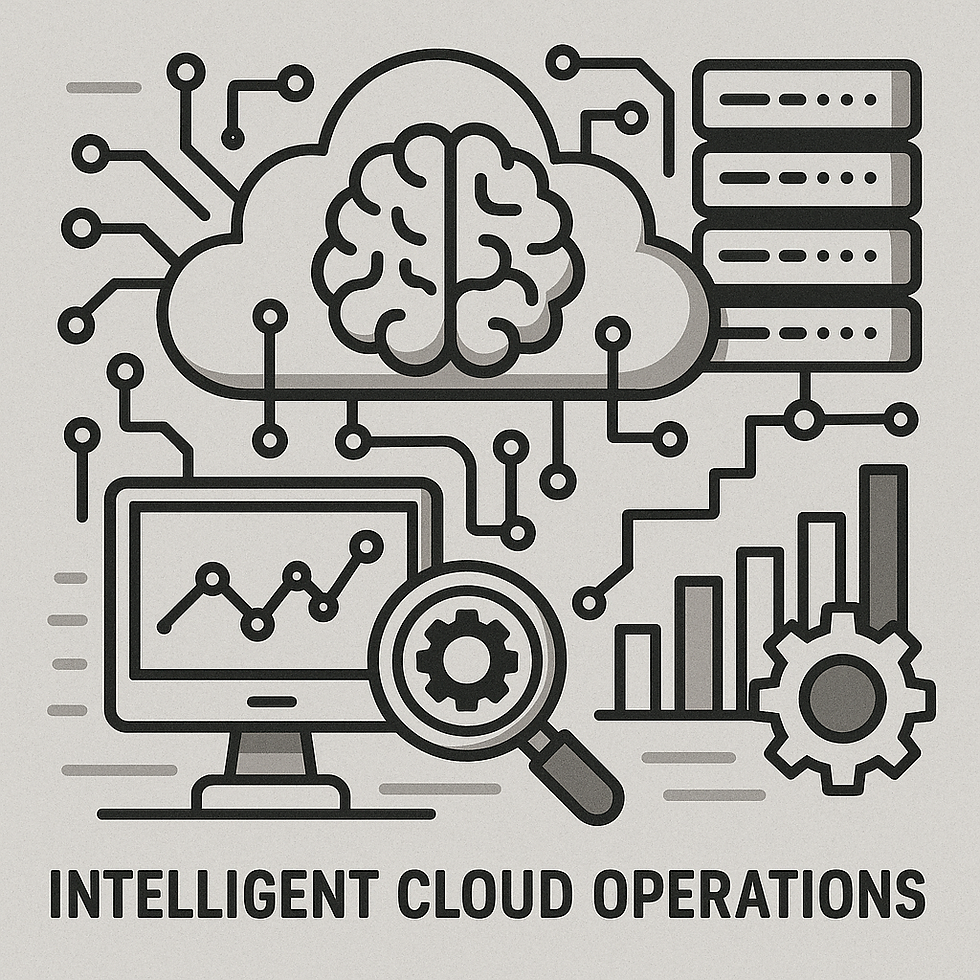AI in Cloud Technology : Powering the Next Era of Intelligent Infrastructure
- Vineet Sharma
- Jun 23
- 4 min read

In today’s digital-ed beyond experimentation to become a core driver of transformation across industries.
The convergence of AI and cloud technology is more than a technical trend—it's a structural shift. Together, they enable intelligent automation, real-time decision-making, cost optimization, and operational resilience at scale.
This article explores how organizations can harness the power of AI within cloud environments to unlock tangible business value and build future-ready infrastructure.
The Strategic Symbiosis of AI and Cloud
Cloud platforms offer the compute, storage, and distributed infrastructure required to build, train, and serve AI models. At the same time, AI makes cloud platforms more intelligent, secure, and efficient.
This mutual reinforcement leads to capabilities that were not possible in traditional environments. Cloud provides agility; AI provides intelligence.
1. AI-Driven Infrastructure Optimization

Managing cloud infrastructure across diverse workloads, services, and geographies is increasingly complex. AI introduces predictability and automation into this process.
Predictive scaling allows resources to adapt dynamically to workload patterns, ensuring service continuity while controlling costs.
Automated cost optimization helps identify underutilized assets, recommend right-sizing, and project usage trends.
Self-healing systems use machine learning to detect failures and trigger automated remediation without human intervention.
These capabilities reduce operational overhead and improve service reliability.
2. Cloud Security Reinforced by AI
Cloud environments face constantly evolving security threats. AI plays a critical role in strengthening defense mechanisms.
Anomaly detection algorithms can identify deviations in user behavior, network traffic, or access logs that indicate potential security incidents.
Adaptive authentication systems adjust security requirements in real time based on contextual risk analysis.
Automated compliance tools assist in monitoring regulatory requirements, tagging sensitive resources, and preparing for audits across frameworks such as ISO 27001, NIST 800-53, and UAE NESA.
AI enables faster threat identification, more accurate risk assessment, and greater confidence in cloud security posture.
3. Intelligent Cloud Operations (AIOps)
AI-powered IT operations—AIOps—use machine learning to manage the volume, variety, and velocity of data generated by cloud-native systems.

Event correlation and root cause analysis help operations teams quickly pinpoint issues across complex stacks.
Proactive alerting prevents service degradation by anticipating issues before they escalate.
Automated remediation workflows reduce mean time to resolution and free up engineers from repetitive tasks.
AIOps shifts operations from reactive to predictive and lays the groundwork for autonomous cloud systems.
4. AI in DevOps and CI/CD Pipelines
AI is enhancing the software development lifecycle by automating key processes and improving software quality.
AI-assisted code reviews and static analysis accelerate development while improving security and maintainability.
Test coverage optimization leverages machine learning to focus test efforts where defects are most likely.
Secure DevOps practices are strengthened by AI tools that monitor for vulnerabilities, hardcoded secrets, and misconfigured infrastructure as code templates.
These integrations enable faster releases, reduced risk, and more secure deployment pipelines.
5. Data-Driven Insights and Decision Support
Cloud platforms house vast volumes of structured and unstructured data. AI enables organizations to turn this data into actionable intelligence.
Machine learning models can be applied directly to cloud-based data warehouses for forecasting, classification, and clustering tasks.
Natural language processing tools help analyze customer feedback, documents, and transcripts at scale.
Real-time dashboards powered by AI enable decision-makers to spot trends, identify anomalies, and monitor performance with greater clarity.
This combination of data and intelligence enhances strategic agility across departments.
6. Generative AI in the Cloud
Generative AI has emerged as a transformative capability for content creation, customer support, knowledge management, and automation.
Cloud platforms now offer:
Access to pretrained large language models (LLMs)
APIs for integrating GenAI into applications
Fine-tuning infrastructure for domain-specific use cases
By hosting GenAI on the cloud, organizations benefit from scalability, security, and integration with other enterprise systems.
7. MLOps: Operationalizing AI at Scale
Moving a model from development to production is only part of the journey. MLOps ensures that machine learning solutions remain accurate, governed, and reliable.

Model versioning and artifact tracking ensure reproducibility and traceability.
CI/CD pipelines for ML automate training, testing, validation, and deployment steps.
Model monitoring and drift detection track changes in data distribution or model behavior to maintain performance.
Governance controls address compliance, access control, and ethical considerations.
MLOps closes the loop between data science and engineering and is essential for sustained AI adoption in enterprise environments.
Challenges to Anticipate
While AI in cloud computing unlocks significant advantages, careful planning and governance are essential:
Data privacy and sovereignty must be protected through regional hosting, encryption, and access control.
Model interpretability is critical in regulated industries where decision transparency is required.
AI lifecycle costs must be managed by optimizing training and inference workloads.
Security of AI models and APIs must be addressed through endpoint protection and adversarial testing.
Organizations should build guardrails early in the AI adoption lifecycle.
Conclusion
AI and cloud computing are no longer separate strategic paths—they are converging to create a new class of intelligent, adaptive infrastructure.
Organizations that invest in this synergy stand to gain:
Resilient and self-optimizing systems
Secure and compliant operations
Faster innovation cycles
Intelligent decision support
As AI continues to evolve, cloud will remain the foundation that enables scale, reliability, and speed.
How V12 Technologies Supports AI-Driven Cloud Transformation
At V12 Technologies, we help enterprises architect and operationalize their intelligent cloud strategy. Our capabilities include:
AI-powered cost and performance optimization
Automated cloud security assessments and remediation
AIOps deployment and cloud observability setup
MLOps lifecycle design and pipeline implementation
GenAI model hosting, fine-tuning, and integration
Whether you’re modernizing legacy infrastructure or launching new AI-driven services, our team can help accelerate your journey with confidence and clarity.
Let’s connect. Visit www.v12technologies.com or reach out for a strategy session tailored to your goals.






Comments